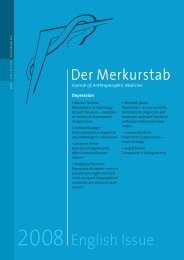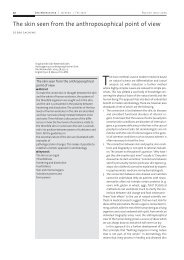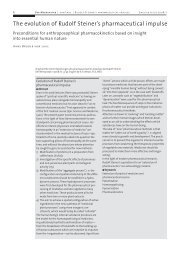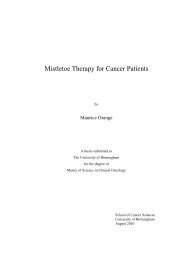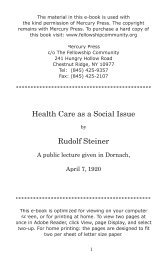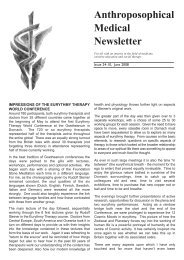Kienle Breast Cancer.pdf - AnthroMed Library
Kienle Breast Cancer.pdf - AnthroMed Library
Kienle Breast Cancer.pdf - AnthroMed Library
Create successful ePaper yourself
Turn your PDF publications into a flip-book with our unique Google optimized e-Paper software.
Cochrane Controlled Trials Register, The NHS Economic<br />
Evaluation Database, Health Technology Assessment<br />
Database), Embase, Medline/Premedline, NLM Gateway,<br />
private databases – from inception of these databases to<br />
December 2008 using the terms (MISTLETOE OR VIS-<br />
CUM? OR MISTEL? OR ISCADOR? OR ISCAR OR<br />
HELIXOR OR ABNOBA? OR ISCUCIN OR ISOREL OR<br />
VISOREL OR ?SOREL OR WELEDA OR WALA OR<br />
EURIXOR OR LEKTINOL OR PLENOSOL OR AVISCU-<br />
MINE) AND (STUDY? OR STUDIE? OR TRIAL OR EVAL-<br />
UAT? OR RANDOM? OR INVESTIG? OR COHORT? OR<br />
KOHORT? OR OUTCOME?). The reference list from each<br />
potentially eligible study, relevant review article and textbook<br />
was checked, and experts in the field and manufacturers<br />
of mistletoe preparations were contacted for<br />
additional reports.<br />
Regarding in vitro or in vivo (animal) experiments on anticancer<br />
effects, we checked title and abstract, and, where<br />
necessary, the whole article of each VAE-related reference<br />
in the databases (Medline/Pubmed and comprehensive<br />
private databases, using above mentioned terms but without<br />
restriction to clinical studies) and in major surveys.<br />
Selection<br />
The following selection criteria were used for inclusion of<br />
studies in the analysis: (I) prospective randomized or<br />
non-randomized controlled clinical trial, or prospective<br />
single-arm cohort study (e.g. phase II trial) or pharmacoepidemiological<br />
cohort study; (II) study population with<br />
breast or gynaecological cancer, i.e. ovary, uterus, cervix,<br />
genital cancer, or cervical intraepithelial neoplasm (CIN);<br />
(III) intervention group treated with VAE preparation;<br />
(IV) clinically relevant outcome (i.e. survival, disease-free<br />
interval, remission, relapse, QoL, or reduction of side<br />
effects or immune suppression during cytoreductive therapy);<br />
(V) completion of study; (VI) published or unpublished.<br />
Studies were excluded if they: only measured<br />
toxicity or tolerability (phase I trial), only measured stimulation<br />
of immunological parameters, were not conducted<br />
on cancer patients, or had a retrospective design<br />
(except pharmaco-epidemiological cohort studies). There<br />
were no restrictions on language.<br />
For in vitro and animal experiments the criteria were<br />
adapted accordingly; unpublished material was not<br />
included however. In vitro experiments were restricted to<br />
cancer cells originating from human tumours.<br />
Validity assessment and data abstraction<br />
Criteria-based analysis was performed on the selected<br />
clinical studies to assess their methodological quality.<br />
Analyses were performed independently by two reviewers<br />
(GK, HK). There were no major differences in study assessment;<br />
disagreements were resolved by discussion. Criteria<br />
for assessing strength of evidence in controlled trials were<br />
adapted from the National Health Service Centre for<br />
Reviews and Dissemination [40] and from criteria for<br />
good methodology as already applied in earlier reviews<br />
on VAE trials [34,36,41]. Quality criteria were adjusted for<br />
cohort studies [36]. Data were abstracted by one reviewer<br />
(GK) and checked by a second reviewer (AG). When necessary,<br />
primary authors of the trials were contacted for<br />
additional information.<br />
Regarding animal experiments we extracted data on study<br />
size, animal model, tumour type, tumour transfer, intervention,<br />
treatment schedule, outcome, physiological<br />
monitoring, side effects, dose-response, randomization,<br />
control treatment, blinding of outcome assessment, publication<br />
in a peer-reviewed journal, and funding source.<br />
Results<br />
Result of literature search<br />
The literature search identified 306 references describing<br />
potential clinical studies (after deletion of duplicates).<br />
After deleting references only describing studies on<br />
immune modulation or toxicity or tolerability (phase I<br />
trial), or only on cancer sites other than breast or gynaecological,<br />
with retrospective evaluation, without quantification<br />
of results, or only investigating complex treatment<br />
regimes, or describing studies already published elsewhere,<br />
48 potential studies were identified that met the<br />
inclusion criteria. Two trials [42,43], conducted in<br />
Poland, were excluded because of severe validity concerns:<br />
a collaborating scientist questioned the alleged randomization<br />
of treatment allocation, and no information could<br />
be obtained from the authors to clarify this question. One<br />
further RCT (on Lektinol ® and breast cancer by Schwiersch<br />
et al.) might have met the inclusion criteria but was<br />
unpublished and unavailable. Thus it was possible to<br />
include 46 studies in this review: 19 RCTs, 16 non-RCTs,<br />
and 11 single-arm cohort studies. Of the 46 studies, 43<br />
were published (4 of these only as an abstract), 1 study<br />
was retrieved as a doctoral dissertation, and 2 were<br />
unpublished reports.<br />
1632 VAE-related references were checked by title, abstract<br />
or whole article, book chapter, or book regarding in vitro<br />
or animal studies. Experiments meeting the inclusion criteria<br />
were excluded if they were described in another publication,<br />
were not published in a scientific journal,<br />
scientific book or as a scientific dissertation, were unavailable<br />
(some dissertations from the 1950s and 60s), or if<br />
they did not present sufficient information.<br />
Characteristics of included clinical studies<br />
Tables 1, 2, 3, 4, 5, and 6 show characteristics of the clinical<br />
studies. Settings of the studies were mostly academic<br />
hospitals, large community hospitals, and specialized




